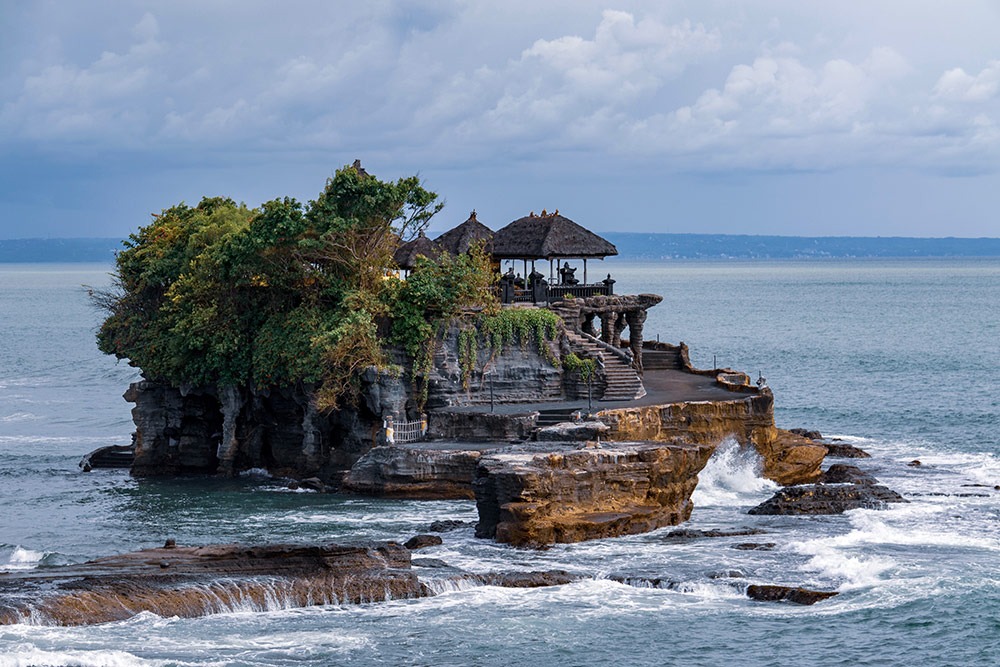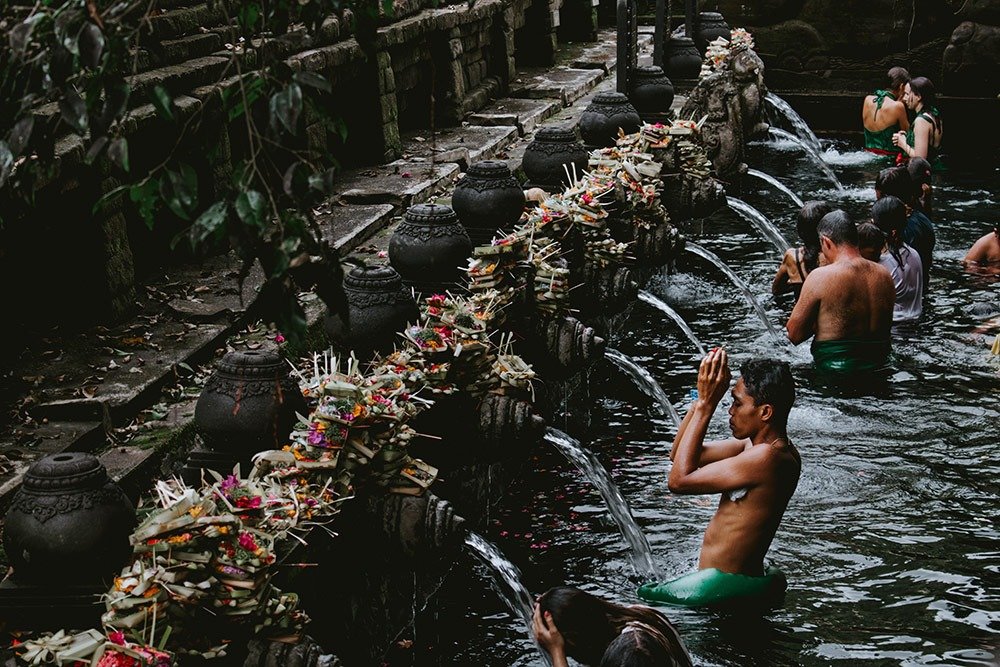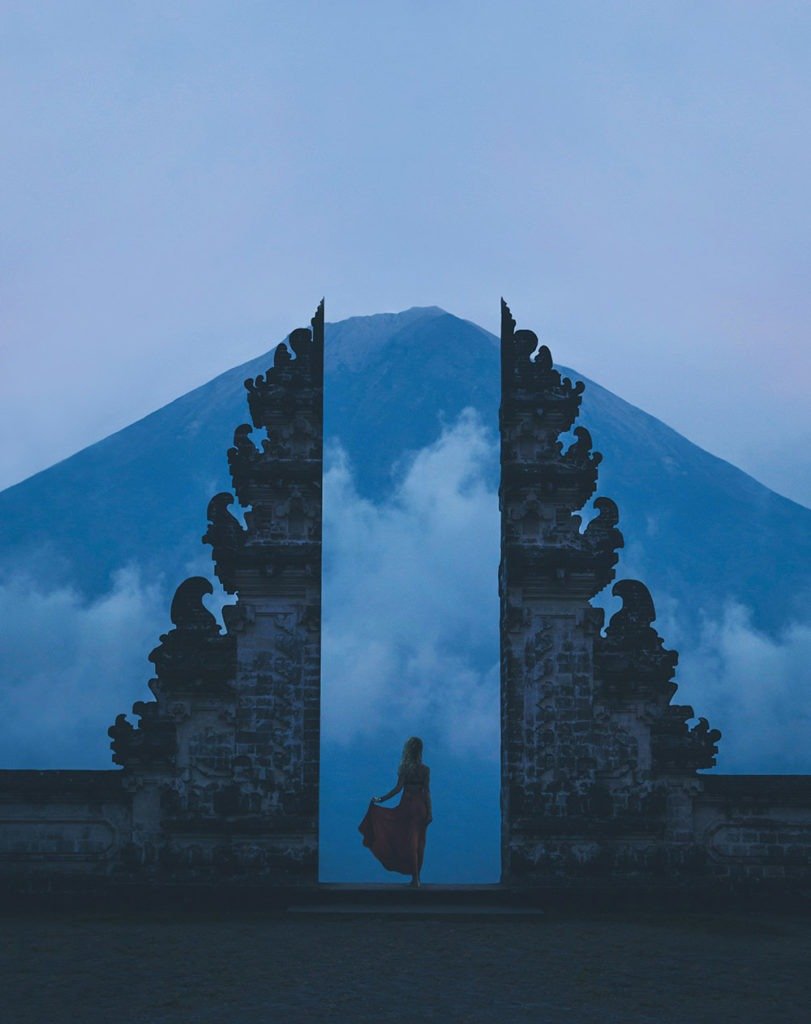

With thousands of temples on the island, it might seem difficult to choose which one to visit. That’s why we wrote this article to give you details about what could be considered as the 10 most beautiful temples. And before to start, it is important to know some basic rules to respect while visiting a temple.
Clothing rules in a temple in Bali
While visiting a temple in Bali, you will notice that everybody wears a colourful scarf tied at the waist with a piece of fabric. This is called a “sarong”. A sarong is a rectangular piece of fabric, often printed with various patterns and colours. Some common designs are flowers, animals or graphic designs. A very traditional dyeing technique is called “Batik”. Batik could mean “writing dots” as this technique uses wax to make drawings on the fabric that will be dyed. But don’t worry in you don’t have your own sarong when visiting a temple in Bali. You can usually buy or rent one at the entrance of any temple in Bali.
Also note that your body must be covered – especially the legs with the sarong – so that you won’t of course be allowed to visit a temple in Bali with an open shirt. As the climate is usually hot in Bali, don’t worry, you will be allowed to visit a temple in Bali wearing a T-shirts. You can read our article about the climate in Bali.
Be respectful while visiting in a temple in Bali
Of course, basic every-day-rules applies and must be respected even more carefully as you visit a temple in Bali.
- Spitting on the floor is forbidden, as well as having a rude behaviour.
- As mentioned in our article about Balinese religion, you will find many offerings in any temple in Bali.
- Do not step a foot on an offering, as it will be very disrespectful towards the person who made it and towards the gods.
- Avoid throwing trash in a Bali temple.
- Remove your shoes at the entrance while visiting a temple in Bali. However, it is not necessarily mandatory.
- One last thing – that has nothing to do with respect but more with a cultural rule – is that women should not visit a temple in Bali during menstruation.
Now you’re ready to visit the best temples in Bali with our Top 10 selection of the best places to visit!
Bali temple #1: Besakih Temple Karangasem
How to better start a list of the Top 10 temples to visit in Bali than with Besakih Temple? Besakih Temple is the holiest temple in Bali. On Bali maps, you will find Besakih located at 62 km from Denpasar and at 22 km from Klungkung. Before to visit this Bali temple located at bottom of the slopes of the Mount Gunung-Agung, don’t forget to bring a jacket just in case. Indeed, it is at 950 meters above sea level and the temperature could be quite surprising. Don’t hesitate to refuse the guides at the entrance of the temple, if you prefer to visit this Bali temple more freely.
“Pura Besakih” Temple is a holy place in Bali composed of twenty-three temples. This Bali temple is dedicated to the three main gods of Hindu religion: Brahma, Vishnu and Shiva. Besides these primary gods, you will find other shrines dedicated to secondary deities. While taking the stairs at the entrance of this Bali temple, look on both sides. On the right, you will find the statues of Evil, staring at you with frightening looks. On the left, you will find statues of Good, with calm and benevolent faces. The architecture is very typical from the Bali temples. Each temple has several “merus”. Merus are thatched roofs that are piled up in successive tiers on the pagoda. The number of thatched roofs can go from one for the humblest shrines to eleven for holiest temples in Bali.
Bali temple #2: Tanah Lot Temple


You will find Tanah Lot temple on Bali maps at less and 20 km from Tabanan and about an hour drive from Ubud. This Bali temple is particularly impressive as it is perched on a massive rock on the sea. As a consequence, it is only accessible by foot when the tide is low. Without surprise, “Pura Tanah Lot” is the Bali temple dedicated to the spirits of the Sea. And Bali being an island, it is all the more important for Balinese people to pray and protect their home island from the wrath of the surrounding element. At sunset, this temple bears a mysterious and magical atmosphere, when the waves break on the black rock and the pagodas with multi-tier “merus” stand out against the orange sky. It is said that this Bali temple is guarded by sea snakes. You might find Balinese priests keeping a snake in one of the rocky holes of the cliff, to embody this Balinese myth.
Bali temple #3: Uluwatu Temple – Pura Luhur Uluwatu
On a map of Bali, Uluwatu temple is located 15 km South from Jimbaran, on the West side of the Bukit peninsula. This temple in Bali is very famous for its emblematic panorama at sunset. The temple is perched at the edge of a cliff, 70 meters above the sea. Just as Tanah Lot Temple, Uluwatu temple is dedicated to the sea, to preserve the Balinese people from its power. This Bali temple is also famous for being the home to a multitude of monkeys. Be careful, as many Bali tourists get tricked by them. Stolen sunglasses, cameras or any other items… But don’t worry, some local people are here to help you reclaim your sunglasses by simply offering the monkey some bananas. At sunset, when the scenery is the most beautiful, go the for “Kecak dance”. This show is a very nice cultural activity to do in Bali. This traditional performance with singing and dancing will also please the children. Read our article to discover other activities to do in a Bali family trip. Uluwatu temple is an unmissable visit that is regularly organized by the Kupu Jimbaran hotel for its guests.
Bali temple #4: Tirta Empul Temple Tampaksiring


Tirta Empul Temple can be accesses from Ubud, and is located near the town of Tampaksiring. It is one of the many visits in Bali that can be organized by the Kupu Barong resort in Ubud, or during the shuttle transfer between this resort and the Kupu Jimbaran hotel.
Tirta Empul literally means “holy spring”. Built for the God Indra, this temple in Bali attracts many religious people as well as Bali tourists to bath in its water. You will enter in a temple complex with several courtyards and ponds. The spring is known to be divine and to have healing powers. It can be found in the largest pond, where you can actually notice water surging out of water. Impressive!
Bali temple #5: Taman Saraswati Temple Ubud
Taman Saraswati Temple is located in Ubud, in the very heart of Bali. Build in the 1950s, this Bali temple is dedicated to the Goddess of arts and learning, Dewi Saraswati. It is known as the “Ubud Water Palace”, and you will easily understand why: to enter the temple complex, you will have to go through a path – similar to a flat bridge – across a vast lotus pond. Taman Saraswati Temple is like a palace sitting in front of a real water garden! The entrance is flanked by frangipani trees on both sides, but unfortunately tourists aren’t allowed to enter the main temple. The large decorated wooden door can be seen from outside, with its shimmering gold and red painting. If you want to relax at the place, you may go to the Lotus Café nearby. Or if you prefer watching an impressive “kecak dance”, it’s also possible from 7:30 in the evening.
Bali temple #6: Lempuyang Temple – Pura Luhur Lempuyang


On a Bali map, you will find Lempuyang Temple located in the East region of Bali, in Karangasem regency, at 1,175 meters above sea level. This temple complex is composed of seven temples. The highest temple on Mount Lempuyan requires to climb as many as 1,700 steps through nature. Like in Uluwatu Temple, you will meet some mischievous monkeys on the way, so watch your sunglasses. Climbing at the top therefore requires good physical condition as well as a bottle of water – not to forget before to go. The three stairs of the lowest temple represent “nagas”, giant mythical snakes, while the impressive white-painted gates mark the entrance of the sanctum. This Bali temple offers a panoramic view of the “Gates to Heaven” with the Mount Agung as a backdrop, the highest volcano of Bali.
Bali temple #7: Ulun Danu and Bratan Lake
Ulun Danu Temple is located near Bedugul village on the Bratan Lake, at 1,500 meters above sea level. In this region, the Bratan Lake is the main source of irrigation of the rice fields nearby. This temple in Bali is so emblematic that it has been depicted at the back of every 50,000-rupiah notes. As for the religion, Ulun Danu Temple is dedicated to Dewi Danu, the Water, River and Lake Goddess. As if it was floating on the lake, the pagoda of eleven “merus” – thatched roofs – reflects on the water. More unexpected, the Stupa at the entrance on the left reveals a Buddhist influence near this Hindu temple and also symbolizes religious harmony.
Bali temple #8: Taman Ayun Temple Mengwi
This charming Bali temple in Mengwi has the particularity of being located on a sort of island, surrounded by a river. Well named, “Pura Taman Ayun” means “temple garden on the water”. This major temple in Bali is composed of two courtyards. The first one hosts a large pond with a fountain in the middle. The second courtyard of the temple has several pagoda-styled towers, with multi-tier thatched-roofs – “merus”. The highest and most important having as much as eleven “merus” piled up on each other.
Bali temple #9: Elephant Cave – Goa Gajah
Goa Gajah is located on a Bali map at 4 km from the center of Ubud, in the village of Bedulu. The very large monstruous face carved out the stone wall – in which the mouth is the entrance – wasn’t made to frighten visitors, but rather to repel evil spirits. The face, looking like an elephant, some will say – hence the name – is in fact a “Bhoma”. Bhoma is a very common deity, guarding the entrance of every temple in Bali. Inside the Goa Gajah cave, you will find a Ganesh sculpture – the Elephant God. That Hindu figure may very well have given its name to the Elephant Cave.
Bali temple #10: Bat Cave – Goa Lawah Temple Klungkung
Goa Lawah Temple is located on the East coast of the island of Bali, in the village of Pesinggahan in Klungkung. We can easily understand where the name “Bat Cave” (Goa Lawah) came from: when you enter the cave, you will see and mostly hear the echoes of the multitude of bats hanging upside down to the cave dome. And the gold-inlaid bat sculpture guarding the entrance of this Bali temple stands as a friendly warning: don’t enter if you’re phobic, although these little flying mammals won’t ever touch any visitor. This cave maybe be of interest for children. This temple hosts several ceremonies every year, where Balinese people dressed up in traditional costumes come to pray and burn incense sticks.